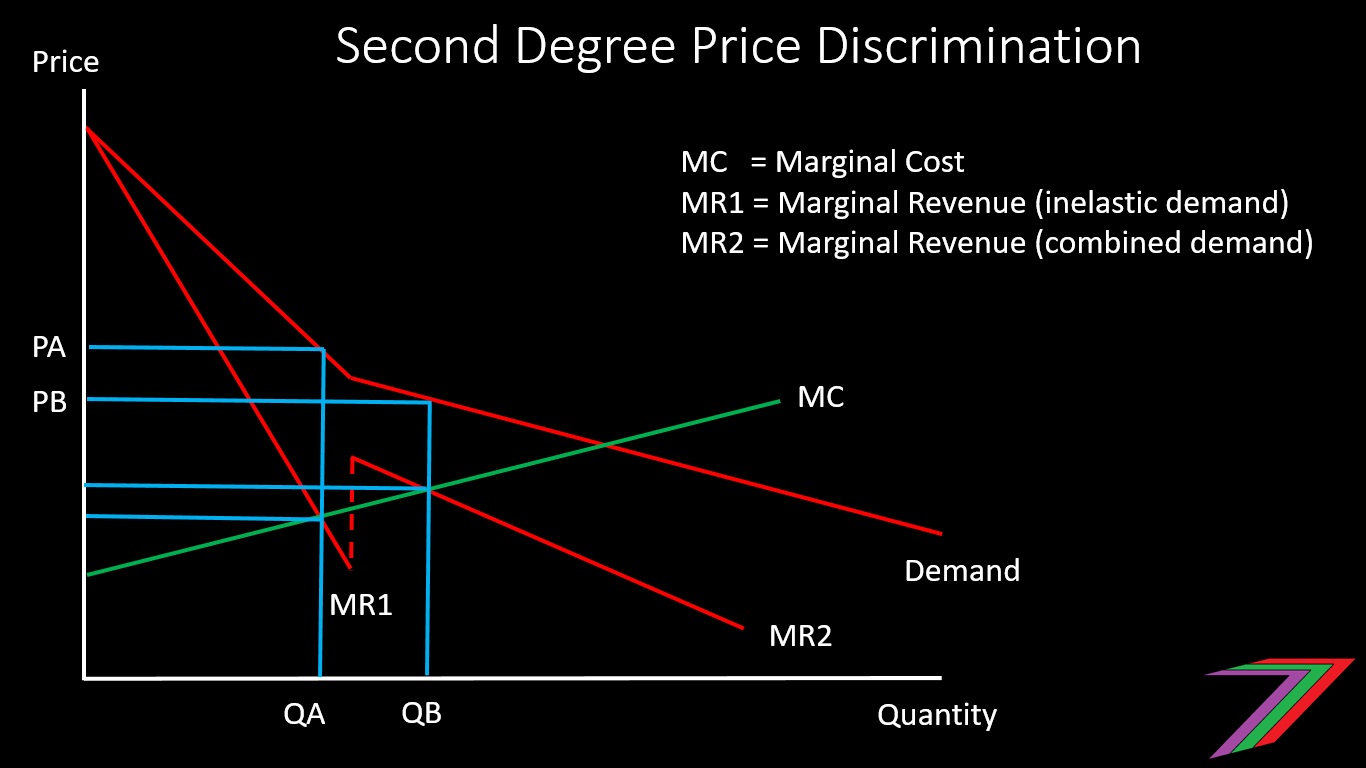Hi Everyone,

Firms often charge people different prices for very similar or even identical products. This is called price discrimination. Charging different prices to different people enables firms to increase their profit. This is because everyone has a different willingness and ability to pay (I will mostly be referring to this as willingness-to-pay in this post). When a firm charges a fixed price for a product, some people will be paying less than the maximum price they would be willing to pay. The difference between a person’s willingness-to-pay and the amount that they actually pay is called consumer surplus. The demand and supply graph in Figure 1 shows the consumer surplus for a product.
### Figure 1: Consumer Surplus

**Consumer surplus is the area shaded purple.**
Firms want to capture some of that consumer surplus to increase their profits. Raising the price would capture some of the consumer surplus of those with higher willingness-to-pay but some people with lower willingness-to-pay will no longer buy the product. Ideally, the firm would like to raise the price for the people with the high willingness-to-pay without raising the price and losing sales from people with lower willingness-to-pay. A possible solution to this problem is price discrimination.
There are three or four typically practiced types of price discrimination. In this post, I will discuss four types of price discrimination. These types are as follows:
- First degree price discrimination
- Second degree price discrimination
- Third degree price discrimination
- Fourth degree price discrimination
The key difference between these types of price discrimination is the extent of consumer surplus each type captures. ‘First degree’ capturing the most and ‘fourth degree’ capturing the least. There is a possibility that third degree price discrimination could capture more consumer surplus than second degree price discrimination as they use different methods to extract consumer surplus; this will be explained later in the post.
## First degree price discrimination
-------
First degree price discrimination occurs when a firm is able to sell its product at the exact value of each person’s willingness-to-pay. If it is done perfectly, the firm can capture the entire consumer surplus. Figure 2 demonstrates first degree price discrimination.
### First degree price discrimination

First degree price discrimination is very rare in its purest form as each person’s willingness-to-pay is unknown and arbitrage (buyers able to resell at a higher price) might be possible. First degree price discrimination is more likely to occur for services, which are not transferable to another person. Healthcare is a typically cited example. Clinics can use means testing to determine how much to charge each patient. However, this will not capture the patient’s entire consumer surplus. Clinics are more likely to practice third degree price discrimination, which I will discuss later in this post.
## Second degree price discrimination
-------
Second degree price discrimination occurs based on the buyer’s selection. The buyer chooses the price they want to pay. Why would someone rather pay more when they could pay less? An example of second degree price discrimination is bulk buying. For someone to obtain a product at a lower price, he or she will need to buy in bulk. A bulk buyer is likely to have an elastic demand for a product. A small reduction in price will entice them to buy more. Lowering the price might attract other buyers with a lower but more elastic demand.
Not everyone is a bulk buyer. Some people might place a high value on obtaining just one of a particular product but place very little value on acquiring a second or third of that product. This type of person would have an inelastic demand. Even if discounts exist for bulk buying, they would choose to pay the higher per unit price for just one of the product.
For example, let’s compare Rod and Ben's demand for doughnuts. Rod has a willingness-to-pay of $3 for his first doughnut, $1.50 for his second doughnut, and $0.50 for his third doughnut. Ben has a willingness-to-pay of $2 for his first, second and third doughnuts. A firm could sell individual doughnuts at $2.20 and a pack of 3 doughnuts for $4.50 (average price of $1.50). Rod would choose to buy one doughnut at the higher average price as he would obtain a higher consumer surplus (3 - 2.2 > 3 + 1.5 + 0.5 - 4.5). Ben would choose to buy the pack of 3 doughnuts to obtain a higher consumer surplus (3 × 2 - 4.5 > 2 - 2.2). In the absence of bulk selling, Ben would not have bought any doughnuts. Figure 3 shows two distinct groups of people with demand curves of different elasticity.
### Figure 3: Second degree price discrimination

In Figure 3, the two demand curves have been combined to create a market demand curve. The firm can price the product at PA, PB or both. If the firm prices at PA, the firm maximises profits from the buyers with inelastic demand but ignores the demand from buyers with the elastic demand. If the firm prices at PB, the firm maximises profits from the elastic demand but the buyers with inelastic demand keep a large portion of their consumer surplus. The firm can price at both PA and PB. PA is the price of the product sold individually and PB is the average price of the product if bought in bulk. The firm is able to maximise profits from the buyers with inelastic demand while still being able to profit off the buyers with elastic demand.
For second degree price discrimination to be effective, the following conditions are required.
- Those buying in bulk should not be able to resell at a profit.
- There needs to be sufficient difference in elasticity between various groups of buyers.
- The firm needs to be able to affordably produce in bulk (e.g. economies of scale)
Other possible examples of second degree price discrimination include airline tickets for different classes, off-peak charging, standby tickets for flights, and clearance sales for perishables or old inventory.
## Third degree price discrimination
-----
Third degree price discrimination occurs when firms are able to segregate buyers. Buyers could be segregated based on:
- Age (For example, elderly people and children are charged less for a train ticket than adults)
- Gender (For example, clubs charging women less for entry)
- Income (For example, clinics charging higher income earners more than lower income earners)
- Location (For example, charging lower entry fees into theme parks for people living in the local area)
Successful segregation enables the firm to sell to different buyers at different prices. Figure 4 demonstrates how third degree price discrimination could be conducted.
### Figure 4: Third degree price discrimination

Firms summate all the demand curves for their product. Using the combined demand curve (average revenue curve), the firm determines the marginal revenue curve for their product. To maximise profits, the firm will determine the quantity to produce by equating marginal revenue to marginal cost. In the absence of price discrimination, the firm would charge price (P) to maximise profits. As the firm can segregate the buyers into 2 groups (based on this example), the firm will charge each group a different price. The firm will equate the marginal revenue from each group with the marginal cost determined in the aggregate model. The price for each group is the point on the respective demand curve at the quantity where marginal cost equals marginal revenue.
## Fourth degree price discrimination
-----
Fourth degree price discrimination occurs when firms sell to all buyers at the same price but incur slightly different costs for providing the product to the buyer. For example, firms often sell clothes of different sizes at the same price. The larger clothes are likely to cost a little more in material but this extra cost is not passed onto the customer. Charging each size at a slightly different price could incur additional administrative costs and the slight variance in price could make marketing more difficult. Another example is airlines charging wheelchair-bound people the same price even though facilitating the wheelchair incurs additional cost. Charging someone in a wheelchair more money for a ticket would be bad for the reputation of the airline, as the airline could be perceived as being exploitative. This would be especially true if other airlines do not charge extra for these services.
## Summary

Price discrimination enables firms to earn higher profits by charging different buyers different prices. Buyers that have higher willingness and ability to pay are charged more than buyers with lower willingness and ability to pay. Price discrimination can also be beneficial to buyers, if more of a product is produced or if discounts are available from the option to buy in bulk.
This post discussed four types of price discrimination. First and third degree price discrimination allows firms to segregate buyers with different demand. First degree price discrimination charges all buyers a different price, whereas third degree price discrimination considers buyers in different groups. Second degree price discrimination enables the buyers to choose what price they want to pay. For the buyer to be able to enjoy the lower price, the firm will often require them to buy more of a product (buy in bulk). Fourth degree price discrimination offers the same price to all buyers but absorbs some of the additional costs for particular buyers. Fourth degree price discrimination does not increase profits directly through the pricing mechanism but can be considered an advantage when competing with other firms.
## More posts

If you want to read any of my other posts, you can click on the links below. These links will lead you to posts containing my collection of works. These posts will be updated frequently.
<a href="https://steemit.com/archive/@spectrumecons/collection-of-works-part-1" rel="nofollow noopener"></a>
<a href="https://steemit.com/archive/@spectrumecons/collection-of-works-part-2" rel="nofollow noopener"></a>
<a href="https://steemit.com/archive/@spectrumecons/collection-of-works-part-3" rel="nofollow noopener"></a>
<center>[](http://steemitboard.com/@spectrumecons)[](http://steemitboard.com/@spectrumecons) [](http://steemitboard.com/@spectrumecons)</center></a>
<center><a href="https://steemit.com/@spectrumecons" rel="nofollow noopener"></center>
# Steem - The Future of DApps
<center></center></a>